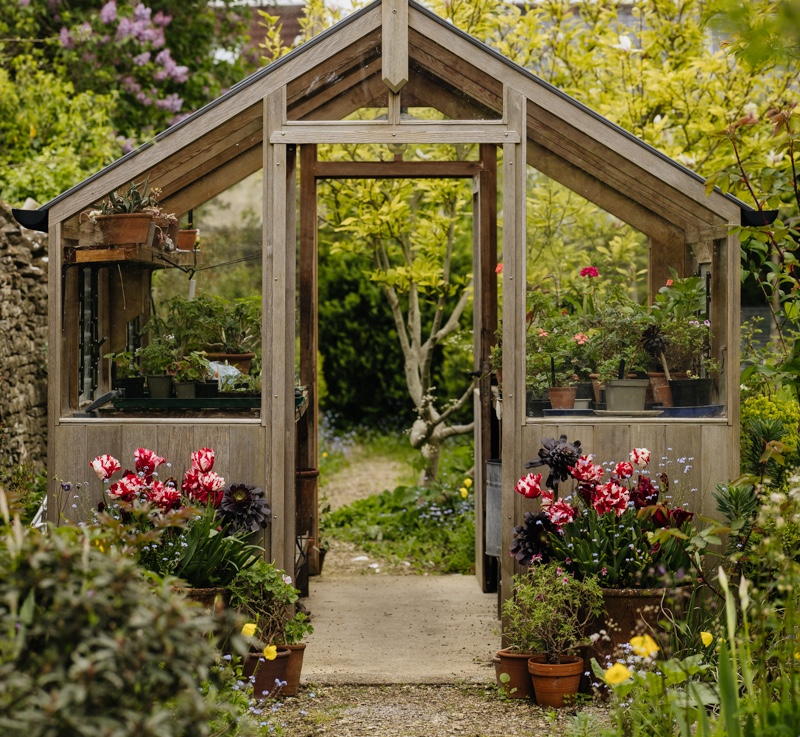If you’ve ever wondered what people mean by “pleasure garden” (when any considered garden is surely a place for pleasure), a visit to Asthall Manor in Oxfordshire, an hour and a half from London, will lay such questions to rest. It is a romantic location—a river running through the garden, views over the 12th century churchyard with the Windrush Valley beyond—but heaps more atmosphere has been added since Rosie Pearson arrived in the 1990s. She hired the more-is-more duo Isabel and Julian Bannerman in the early years, and now every wall is draped in a hundred-plus varieties of rose, with many more delights in the wider garden. It is a spirited mix of formal and informal, further enlivened by the temporary presence of 350 sculptures. The biennial selling show, On Form, is a pleasure garden par excellence.
Photography by Britt Willoughby Dyer for Gardenista.

Modern sculpture in a garden can fill people with horror, in a similar way that traditional garden ornament is beneath the contempt of others. On Form is a “stone only” show, allowing great variety within a narrow framework. There are 350 works by 35 artists in a selling exhibition that was curated over two years by Rosie Pearson and Anna Greenacre.

It’s the opposite of “look, don’t touch.” As Rosie explains, “That’s one of the reasons for having stone only, because it’s not damaged by human touch. In fact, it’s sometimes improved by touch.”

“We have far more sculpture than we would advise anybody to have,” says Rosie. “I mean, you don’t want sculpture around every corner for the rest of your life but actually, for one glorious, blooming, over-the-top exhibition, it’s wonderful that there is a sculpture around every corner.”

Anna, the curator, has been with On Form for 17 years. She assesses work with the garden in mind, while the head gardener, Owen Vaughan approaches the garden with sculpture in mind. He has carved out new spaces in the wilderness areas, devised nooks in topiary, and used devices that are as simple as paths in long grass for accommodating artworks of carved stone. People see something situated perfectly, like the whale tale below, and want to translate it into a similar situation, if they can get past the idea that they can’t take the garden with them as well.

The garden has enough variety to create different settings for series of pieces; it is highly structured but with a looseness that allows the sculpture to breathe. In a successful sculpture-pleasure garden, the landscape is as good as the art and vice versa.


On Form began in 2002, after Rosie commissioned some gate post finials from the sculptor Anthony Turner (see above and the final picture). Non-identical and botanically-inspired, they caught the attention of passersby, who would comment or send notes of appreciation. “I loved them when they came and I was interested in people’s reactions,” says Rosie. “We were sending out the message that this is a place which is sort of welcoming and slightly mysterious. You never quite know what’s going to happen here.”

“You quite often get people who arrive saying, ‘Oh, I’ve only come for the garden.’” Says Rosie. When they finally leave, having taken in the garden and valley, church and churchyard, as well as the semi-detached ballroom, they have also discovered a new and unexpected passion for stone.

“There is a feeling of flow,” says Rosie. “It’s to do with the river, the valley, the contrast between formality and freedom, wildness and structure.”

On Form, a selling exhibition, continues until July 10 at Asthall Manor, Burford, Oxfordshire.
Look for Kendra’s post next week on the old roses of Asthall. In the meantime, for more gardens in the Cotswolds, see:
- 10 Garden Ideas to Steal from the Cotswolds
- Required Reading: Three Generations of Women Gardeners in the Cotswolds
- Garden Visit: A Modern Garden for a Gothic Estate in the Cotswolds












Have a Question or Comment About This Post?
Join the conversation (0)